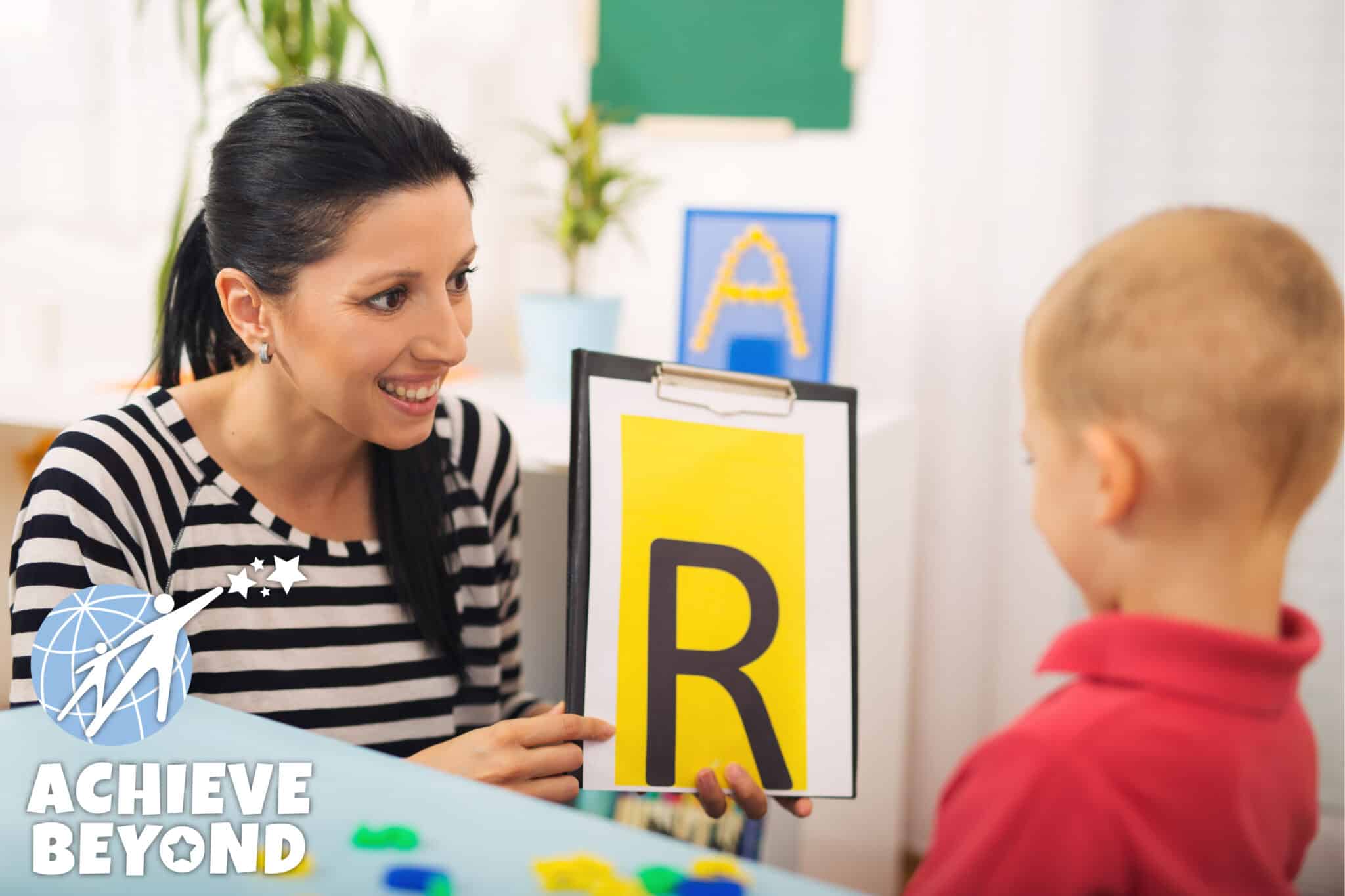R Words Speech Therapy Exercises
Written By: Michelle E. Sisto, MS CCC-SLP TSSLD S

One of the many skills that can be targeted by speech language pathologists is speech sound acquisition. As our children grow, they acquire different sounds that they can use to produce target words while communicating. One of the most difficult sounds to produce is the /r/ sound. The /r/ sound is generally acquired between the ages of 3 and 6 years old (ASHA, n.d.), meaning that a two year old that isn’t producing /r/ would not be an immediate cause of concern.
There are many reasons that /r/ is a difficult sound to acquire and teach. Firstly, when producing the /r/ sound, it is not visible within the mouth, during production. Whereas earlier developing sounds, such as /b/ and /p/ are produced by visibly placing both lips together, /r/ can be produced in two distinct ways that are not visible. One way /r/ can be produced is “retroflexing” the tongue. This is where the tip of the tongue is raised and angled up towards the bumpy part of the roof of your mouth (the alveolar ridge). Another way /r/ can be produced is by “bunching” the tongue. When the tongue is “bunched”, it is placed where the sides of the back of the tongue go up and the tip of the tongue is brought backwards or retracted. All of these placements occur within the mouth which make it challenging to describe and teach. In addition to placement, all sounds are grouped based on the way they are produced. The sounds /r/ and /l/ are grouped as liquid sounds. Liquid sounds are produced when the tongue produces a partial closure in the mouth.
There is no benefit for teaching the retroflexed /r/ over the bunched /r/ or vice versa. It is whatever is easiest and most comfortable for the client. To start, discussing the parts of the mouth that are used to produce this sound is helpful. Using a mirror, allow the child to explore their tongue, lips, and teeth. This can help narrow down if the child can isolate the movements of their articulators or if that is something that should be addressed. After using a mirror, create a fake tongue using play doh! Instruct the child on how to model the play to look like their tongue. Prompting the child to manipulate the play doh to “bring the back sides up and pull the tongue back” or “lift the tongue tip up”. Challenge the children to make their tongue imitate and look like the model tongue they just created to recreate the tongue shape that is needed.
Children also need to have awareness of discrimination between /r/ and other sounds, such as /l/ and /r/. Using auditory discrimination is one way to test the child’s discrimination skills. Use pictures of minimal pairs [two words that vary by only a single sound], such as rake and lake or row and low. Present the pictures to the child and have them point to or pick up the picture of the word that was said. This needs to occur before practicing the /r/ sound occurs, in order to ensure this skill is mastered or working on /r/ would be fruitless.
Once it is determined that the child has these discriminatory skills, there are different exercises that can be utilized to teach and practice the /r/ sounds for children who are experiencing difficulty.
-
Drinking with a Straw
Present the child with a drink and a straw. Have them sip the liquid through the straw. Ask them to think about what their tongue does while they are drinking. Have them explain their tongue movement to you. This increases awareness of tongue movements that mimics the retraction of the tongue during /r/ production. -
Pretend to be a Frog
Cut up green pieces of paper in the shape of a lily pad. Place the lily pads all over the room. Have the child jump from lily pad to lily pad but the catch is they have to produce “ribbit” to jump the the next lily pad. They earn jumps by producing the /r/ sound. Set an amount of times they need to say “ribbit” before jumping to the next lily pad to get in repetitions of the /r/ sound. -
Feed the Rabbit
Use a stuffed animal rabbit or print out a picture of a rabbit. Explain to the child that the rabbit is hungry! Print out small pictures of /r/ words and put them on individual pieces of paper. Hand the child one by one and have them produce the word and feed the rabbit the paper. Say “feed the rabbit a rhino!” or “feed the rabbit a raisin!”. You could even set a target number of productions they must produce before the rabbit gets to eat the pictures. -
Transportation Race
Set up an obstacle course in your living room. Grab all of the trucks, cars, and trains you can find! Race with your child through the different obstacle courses with the vehicles. Practice target words, such as car, race, and room (car sound). Provide models for the child to imitate while utilizing the words throughout the activity.
There are also supports that should be used to help support the child mastering the /r/ sound:
-
Video and Auditory Feedback
While practicing /r/ words, video and audio record the child’s sound production. After the child produces an /r/ word, model the appropriate producing of any words that are mispronounced. After practice, have the child watch and listen back to the video for them to hear the difference between the sounds to build awareness, as well as imitation opportunities. -
Visual Feedback
Practice /r/ words in front of a mirror. Some children replace /r/ with /w/. Mirrors provide visual feedback to see the difference between lip shape and movement when producing those two different sounds (/w/ rounds the lips, while /r/ slightly retracts the lips).
Above all else, try not to stress yourself or your child! These activities and supports should be fun and engaging! Progress will be made when the child is relaxed. The rule of thumb is if you are bored, then the child will be bored as well. Make all activities into a game and put your own spin on it! Overall, enjoy spending time, making memories with your child, and make targeting the /r/ sound just part of the experience.
Date Posted:
January 24, 2023
Share this blog
Categories
Recent Blog Posts
-
A Day in the Life of an Early Intervention Speech Therapist
-
 What Does an Early Childhood Speech Therapist Do?
What Does an Early Childhood Speech Therapist Do? -
 Behavior Therapists: A Career Merging the Science of Learning with Fun and Compassion
Behavior Therapists: A Career Merging the Science of Learning with Fun and Compassion -
 A Day in the Life of a Home-Based Early Intervention Provider
A Day in the Life of a Home-Based Early Intervention Provider -
 Enhancing ABA Therapy with Compassionate Care: Empowering Individuals through Positive Reinforcement
Enhancing ABA Therapy with Compassionate Care: Empowering Individuals through Positive Reinforcement




